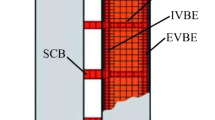Abstract
In this paper, a novel self-centering buckling-restrained energy dissipater (SC-BRED) with pretensioned basalt fiber-reinforced polymer composite tendons is firstly introduced. Furthermore, based on the SC-BREDs, a self-centering steel truss coupling beam (SCCB) is proposed to improve the seismic resilience of coupled wall structures. The SCCB consists of chord members at the top and bottom, respectively, and two SC-BREDs are employed in the diagonal direction. The chords are connected to the adjacent wall piers by hinge joint and all inelastic deformations are concentrated on the SC-BREDs, which can be easily installed and quickly repaired for post-earthquake. This paper mainly focused on the numerical and theoretical analyses of the SCCB, and nonlinear numerical models are developed in PERFORM-3D. An 11-story prototype structure was designed per Chinese code. The seismic behaviors of the hybrid coupled wall system with SCCBs (HCW-SC), the hybrid coupled wall system with steel truss coupling beams (without pretensioned tendons), and the reinforced concrete coupled wall system with RC coupling beams were evaluated and compared under maximum considered earthquake. Results showed that the HCW-SC can achieve excellent lateral strength, stiffness, and ductility as well as reduce the residual displacements of the structure after earthquake.

























Similar content being viewed by others
References
ASCE (2014) Seismic evaluation and retrofit of existing buildings (ASCE/SEI 41–13). American Society of Civil Engineers, Reston
Brando G, D’Agostino F, De Matteis G (2013) Experimental tests of a new hysteretic damper made of buckling inhibited shear panels. Mater Struct 46(12):2121–2133
Chan RWK, Albermani F, Kitipornchai S (2013) Experimental study of perforated yielding shear panel device for passive energy dissipation. J Construct Steel Res 91:14–25
Cheng MY, Fikri R, Chen CC (2014) Experimental study of reinforced concrete and hybrid coupled shear wall systems. Eng Struct 84:214–225
CMC (Ministry of Construction) (2010) Code for seismic design of buildings (GB 50011-2010). China Architecture & Building Press, Beijing
Deng K, Pan P, Li W, Xue Y (2015) Development of a buckling restrained shear panel damper. J Constr Steel Res 106:311–321
Ding Y (2014) Cyclic tests of unbonded steel plate brace encased in steel-concrete composite panel. J Constr Steel Res 102:233–244
Egorova N, Eatherton MR, Maurya A (2014) Experimental study of ring-shaped steel plate shear walls. J Constr Steel Res 103:179–189
FEMA (2012) Seismic performance assessment of buildings, methodology, FEMA P-58-1, vol 1. Prepared by the Applied Technology Council for the Federal Emergency Management Agency, Washington, DC
Fortney PJ, Shahrooz BM, Rassati GA (2007) ASCE large-scale testing of a replaceable “fuse” steel coupling beam. J Struct Eng 133(12):1801–1807
Galano L, Vignoli A (2000) Seismic behavior of short coupling beams with different reinforcement layouts. ACI Struct J 97(6):876–885
Gong B, Shahrooz BM (2001a) Concrete-steel composite coupling beams. I: component testing. J Struct Eng 127(6):625–631
Gong B, Shahrooz BM (2001b) Concrete-steel composite coupling beams. II: subassembly testing and design verification. J Struct Eng 127(6):632–638
Harries KA, Mitchell D, Cook WD, Redwood RG (1992) Seismic response of steel beams coupling reinforced concrete walls. J Struct Div 119(12):3611–3629
Ji X, Wang Y, Ma Q, Taichiro O (2017) Cyclic behavior of replaceable steel coupling beams. J Struct Eng 143(2):04016169
Ji X, Liu D, Hutt CM (2018) Seismic performance evaluation of a high-rise building with novel hybrid coupled walls. Eng Struct 169:216–225
Jin S, Bai J, Ou J (2017) Seismic behavior of a buckling-restrained steel plate shear wall with inclined slots. J Construct Steel Res 129:1–11
Li Y, Liu Y, Meng S (2019) Seismic performance evaluation of coupled wall system with novel replaceable steel truss coupling beams. Adv Struct Eng 22(12):1284
Lu X, Chen C, Jiang H et al (2018) Shaking table tests and numerical analyses of an RC coupled wall structure with replaceable coupling beams. Earthq Eng Struct Dyn 47(9):1882–1904
Luco N, Cornell CA (1998) Effects of random connection fractures on the demands and reliability for a three-story pre-Northridge (SMRP) structure. In: Proceedings of the sixth US national conf on earthquake eng, Earthquake Engineering Research Institute, Oakland, California
Mattock AH, Gaafar GH (1982) Strength of embedded steel sections as brackets. ACI Struct J 79(2):83–93
McCormick J, Aburano H, Ikenaga, M, Nakashima M (2008) Permissible residual deformation levels for building structures considering both safety and human elements. In: Proceedings of 14th world conference on earthquake engineering, Seismological Press of China, Beijing, Paper ID 05-06-0071
Paulay T (1971) Coupling beams of reinforced concrete shear walls. J Struct Eng 97(3):843–862
Paulay T, Binney JR (1974) Diagonally reinforced coupling beams of shear walls. Shear in Reinforced Concrete, SP-42. Farmington Hills, MI: American Concrete Institute, pp 579–98
Paulay T, Priestley MJN (1992) Seismic design of reinforced concrete and masonry buildings. Wiley, New York, p 768
Shahrooz BM, Remmetter MA, Qin F (1993) Seismic design and performance of composite coupled walls. J Struct Eng 119(11):3291–3309
Valizadeh H, Sheidaii M, Showkati H (2012) Experimental investigation on cyclic behavior of perforated steel plate shear walls. J Constr Steel Res 70:308–316
Vamvatsikos D, Cornell CA (2002) Incremental dynamic analysis. Earthq Eng Struct Dyn 31(3):491–514
Vian D, Bruneau M, Purba R (2009) Special perforated steel plate shear walls with reduced beam section anchor beams II: analysis and design recommendations. J Struct Eng 135(3):221–228
Wang X, Shi JZ et al (2014) Creep behavior of basalt fiber reinforced polymer tendons for prestressing application. Mater Des 59:558–564
Wei MW, Liew JYR, Du Y, Fu XY (2017) Seismic behavior of novel partially connected buckling-restrained steel plate shear walls. Soil Dyn Earthq Eng 103:64–75
Acknowledgements
This research was funded by National Natural Science Foundation of China Grant Number (51908191) and China Postdoctoral Science Foundation Grant Number (2019M660103).
Author information
Authors and Affiliations
Corresponding author
Additional information
Publisher's Note
Springer Nature remains neutral with regard to jurisdictional claims in published maps and institutional affiliations.
Rights and permissions
About this article
Cite this article
Li, Y., Liu, Y. & Chen, Z. Seismic response assessment of a hybrid coupled wall structure with novel self-centering steel truss coupling beams. Bull Earthquake Eng 18, 2657–2680 (2020). https://doi.org/10.1007/s10518-020-00801-7
Received:
Accepted:
Published:
Issue Date:
DOI: https://doi.org/10.1007/s10518-020-00801-7




